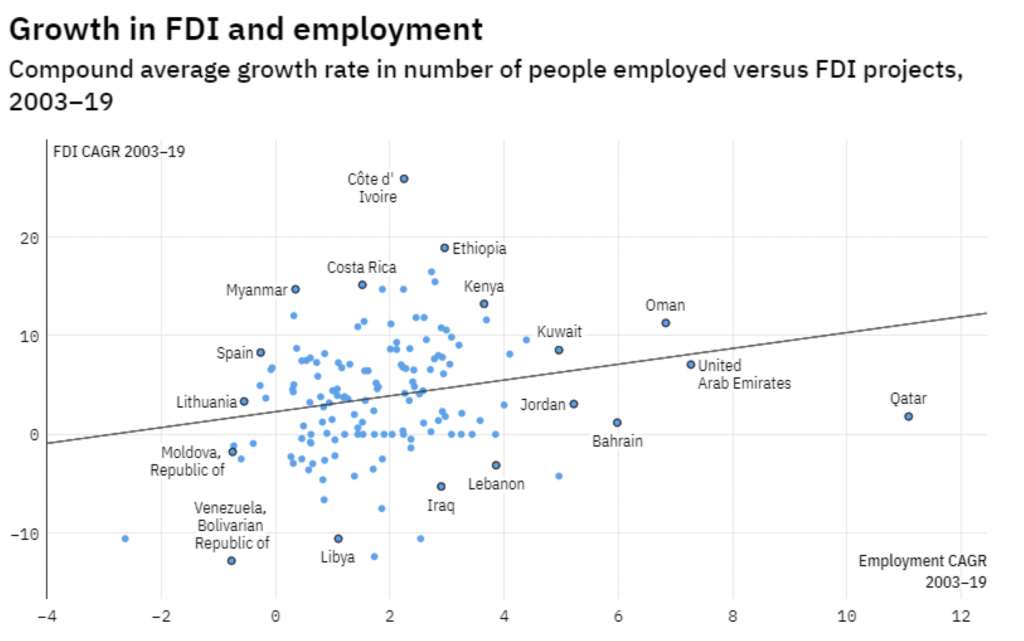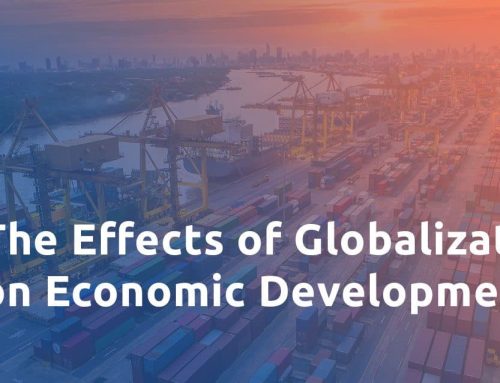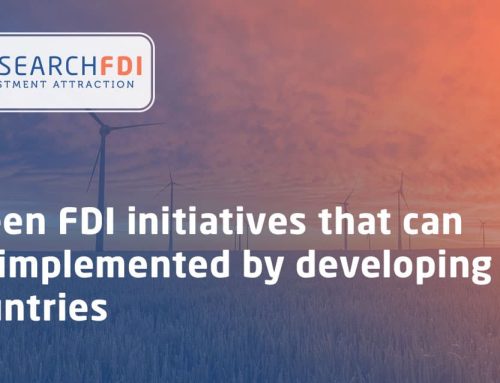Green Foreign Direct Investment (FDI) has the potential to greatly advance sustainable development. It is crucial for the enhancement of growth and innovation, through the quality of jobs it creates, and the development of human capital which further raises living standards.
What are the UN’s Sustainable Development Goals?
At the 2015 United Nations Summit, world leaders made the decision to adopt the 17 Sustainable Development Goals (SDGs) as part of the 2030 Agenda for Sustainable Development. These goals, planned to be achieved within 15 years of coming into force, were built off the previous successes of the Millennium Development Goals (MDGs) and aim to create a stronger mobilization of efforts to end all forms of poverty, fight inequalities and tackle climate change.

These goals create a universal call to action for all countries and recognize the importance of strategies that promote economic growth and address a variety of social needs in the fight towards ending poverty, protecting the planet and promoting peace and prosperity for all people.
The COVID-19 pandemic has significantly slowed progress toward achieving these goals by 2030. The pandemic pushed an additional 124 million people into poverty in 2020 alone. Over 255 million jobs were lost, and the number of people suffering from hunger increased by approximately 132 million. It is evident that the COVID-19 pandemic both exposed and intensified inequalities globally.
The need for green FDI has now become more pressing than ever, if we are to rebuild after the pandemic and attain the Sustainable Development Goals.
The Progress of the SDGs
The SDGs were created to be the blueprint for achieving a better and more sustainable future for all. However, achieving the Sustainable Development Goals by 2030 is an expensive goal that requires significant investments in innovation, infrastructure and technology.
Prior to COVID-19, UNCTAD estimated that developing countries’ SDG financing gap was 2.5 trillion USD per year. The impact of the COVID-19 pandemic on investment levels has now further compounded the problem. In addition, COVID-19 caused the world to reverse its progress towards the SDGs in 2020 for the first time.
The Role of Green FDI
To achieve the 2030 Sustainable Development Goals, green FDI can be channeled towards related sectors. FDI often makes a positive contribution to the host country’s economy through the transfer of money, knowledge, skills, and technology that would otherwise not be present.
Green FDI plays a positive role in the achievement of all 17 SD goals, but it has the greatest impact on goal 8, “Decent work and economic growth” and goal 9, “industry, innovation and infrastructure”
SDG 8: Decent Work and Economic Growth
A key benefit of FDI is the employment and economic boost it can provide to host countries. FDI can create new jobs and opportunities that would not be available without investors creating new companies overseas. Additionally, FDI can be used as a catalyst for stimulating the economy of a host country. This will result in an environment that will be beneficial for companies, investors, and the overall economic growth of the region.
Goal 8 of the sustainable development goals focuses on promoting inclusive and sustainable economic growth, as well as full and productive employment and decent work for all. Green FDI can be used to achieve this goal through the economic and employment boost it provides.

Graph 1: Growth in FDI and employment
A country’s employment rate and the amount of foreign direct investment (FDI) it attracts are directly correlated. Investment Monitor studied this correlation from 2003 to 2019, and the data showed that countries with decent employment rates received more FDI projects than those with low employment rates.
Green FDI initiatives ensure that the positive impacts of FDI on employment rates and economic development in a host country will continue, an aspect crucial to the achievement of SDG8. In addition to creating standards for investing in host countries similar to those in developed markets, green FDI encourages investment into sustainable industries.
SDG 9: Industry, innovation and infrastructure
Further benefits of FDI include the exchange of knowledge, technology and skill that occur in areas it would not otherwise be possible. Consequently, the host country’s education and human capital are enhanced as workers acquire these skills.
Goal 9 of the sustainable development goals focuses on building a resilient infrastructure, promoting inclusive and sustainable industrialization, and fostering innovation. Foreign direct investment has been a driving force for technological innovation within host countries, but these innovations are often associated with environmental pollution. However, Green FDI is changing this, with initiatives that are focused on sustainable industries and industrialization.
Green FDI promotes investment in sectors that are aligned with the achievement of the SDGs. According to Investment Monitor, Investments in agriculture, climate action, technology and services are some areas that could provide the needed growth to meet the targets for SDG9. FDI initiatives promoting green investment opportunities are targeted towards sectors like electric vehicle manufacturing, renewable energy like hydropower, modular housing, and the emerging green 3D print manufacturing industry.
An Overall Increased Standard of Living
Green FDI plays a vital role in achieving the Sustainable Development Goals, and its role goes beyond SDG8 and SDG9. The positive effects that occur from FDI can be seen in all 17 of the goals.
The enhancement of growth and innovation that creates quality jobs and develops human capital can aid in ending gender inequality, with more employment opportunities being made available for women worldwide. Furthermore, an increase in human capital for the host country means that fewer people will fall under the poverty line and fewer will suffer from hunger. An increase in human capital can also increase the health and wellbeing of citizens.
The benefits of Green FDI are evident, and host countries are increasingly seeking to find more green investors. To do this many governments are finding new ways to become attractive destinations for sustainable investment.
Incentives for Green FDI
The most popular incentives used by host countries to attract new investments are fiscal FDI incentives. There are many common tax incentives related to FDI, and more that are being introduced specifically for Green FDI – these tax advantages are often a large motivator towards an investors choice to go green.
According to FDI Intelligence many of the common tax incentives can be broadly separated into several major categories:
- reduced corporate income tax rates;
- tax holidays (no taxes for a period of time);
- investment allowances and tax credits (reductions in taxes that are based on the amount of investment and are in addition to normal depreciation);
- accelerated or free depreciation (allowing businesses to write off depreciation more rapidly);
- exemptions from indirect taxes, ie, import tariffs on inputs; and
- export-processing zones (special zones for exporters; enterprises in such zones are typically exempt from all indirect taxes or, in some cases, all direct taxes).
Tax incentives for Green FDI vary by host country, with some offering more than others. The EU for example is strongly committed to meeting their ambitious emissions goals, as such they are strongly encouraging the use of renewable energy and have dedicated over a third of their new €1.8 trillion budget towards sustainable development. Companies can receive subsidies for investing in cleantech, adopting circular economy processes, or greening their supply chains. The EU has even dedicated their €1 billion Innovation Fund to support floating wind farms, carbon capture mechanisms and energy storage with the goal of making sectors such as cement and steelmaking more sustainable.
North American countries have introduced similar incentives to those of the EU, with the US government creating federal incentive programs that allow companies to potentially qualify for 10%-25% tax credits for the cost of their investment for wind, solar and combined heat, and power. The Canadian government offers incentives through funding that support investments in projects to reduce emissions and investments that create jobs in sustainable fields. These incentives are not only in developed countries, but they are also especially encouraged in developing countries that could benefit the greatest from the effects of Green FDI. The World Trade Organization (WTO) provided five suggestions for initiatives that developing countries specifically should adopt to both make to boost sustainable development.
Green Foreign Direct Investment is clearly playing an important role in the achievement of the 2030 Sustainable Development Goals, and the positive benefits they achieve are vital to the goal of achieving a better and sustainable future for all. It is clear that Green FDI’s presence in sustainable development is not going to slow down any time soon, given the high acknowledgment of the benefits it brings to host countries, as well as the new incentives that have been implemented to encourage it.







